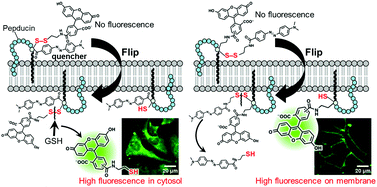FRET-based imaging of transbilayer movement of pepducin in living cells by novel intracellular bioreductively activatable fluorescent probes†
Abstract
To elucidate the mechanisms of direct transmembrane penetration of pepducins, which are artificial

* Corresponding authors
a
Laboratory of Pharmaceutical and Medicinal Chemistry, Gifu Pharmaceutical University, 1-25-4 Daigaku-nishi, Gifu, Japan
E-mail:
hnagasawa@gifu-pu.ac.jp
Fax: +81-58-230-8112
Tel: +81-58-230-8112
To elucidate the mechanisms of direct transmembrane penetration of pepducins, which are artificial

 Please wait while we load your content...
Something went wrong. Try again?
Please wait while we load your content...
Something went wrong. Try again?
M. Tsuji, S. Ueda, T. Hirayama, K. Okuda, Y. Sakaguchi, A. Isono and H. Nagasawa, Org. Biomol. Chem., 2013, 11, 3030 DOI: 10.1039/C3OB27445D
To request permission to reproduce material from this article, please go to the Copyright Clearance Center request page.
If you are an author contributing to an RSC publication, you do not need to request permission provided correct acknowledgement is given.
If you are the author of this article, you do not need to request permission to reproduce figures and diagrams provided correct acknowledgement is given. If you want to reproduce the whole article in a third-party publication (excluding your thesis/dissertation for which permission is not required) please go to the Copyright Clearance Center request page.
Read more about how to correctly acknowledge RSC content.
 Fetching data from CrossRef.
Fetching data from CrossRef.
This may take some time to load.
Loading related content
